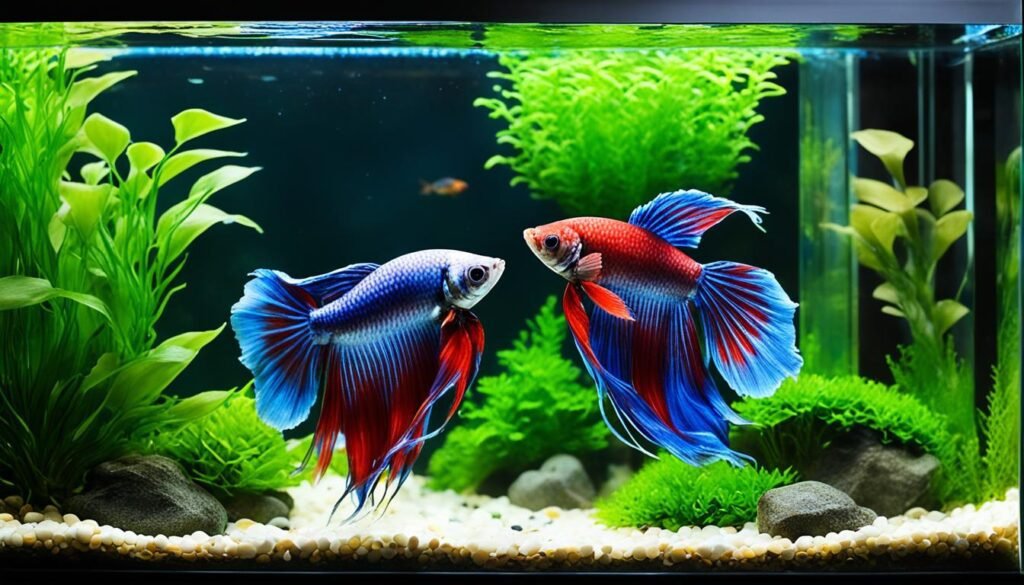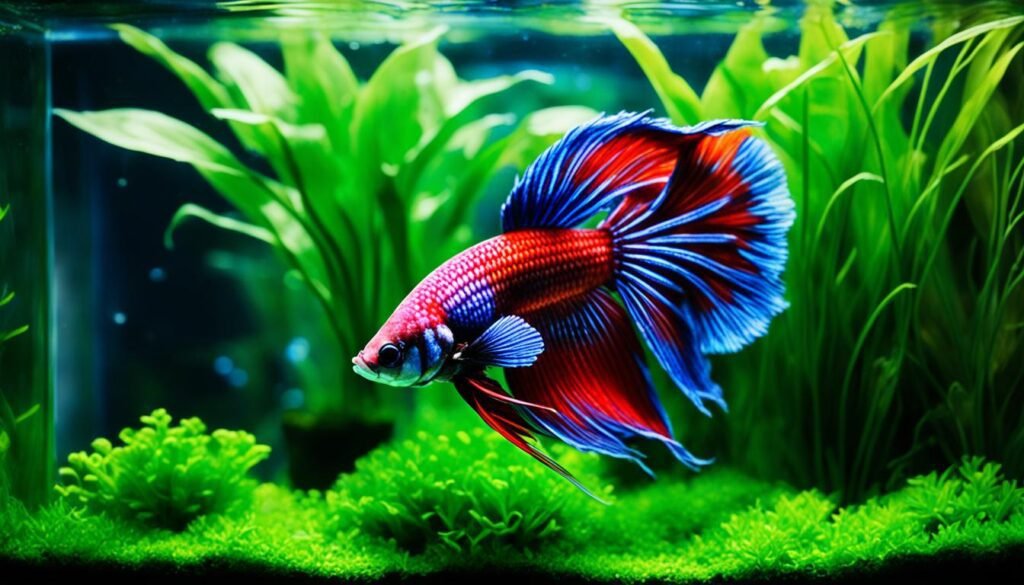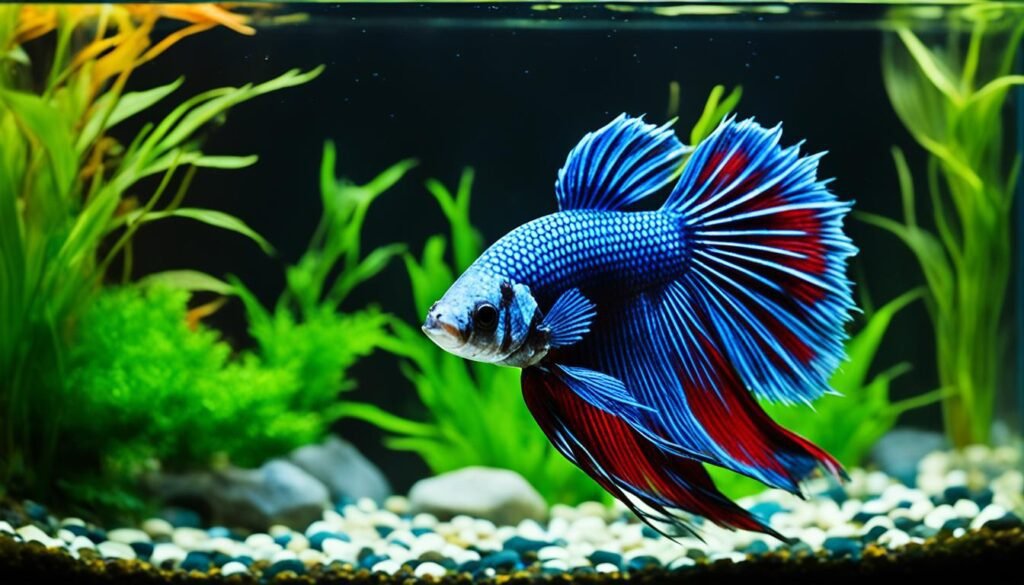Siamese fighting fish, also known as betta fish, are vibrant and elegant. But there’s a widespread misconception about how to house them. They are often seen in small tanks or decorative bowls. Yet, their care requirements are critical for their well-being.
To care for betta fish right, we must know their natural habitat. Unlike the small spaces they’re often kept in, they thrive with more room. This space allows them to swim freely and enjoy their environment.
Misconceptions Surrounding Betta Splendens’ Habitat
It’s vital to clear up false beliefs about Betta Splendens‘ living conditions. This ensures their health and happiness. Though many associate these colorful fish with fish bowls and tiny tanks, such places don’t suit them. We must correct the myths about caring for Betta fish.
A common, but wrong, idea is that Betta Splendens come from still waters. So, people think they can live happily in small, unfiltered bowls. Their actual homes are the wide, oxygen-filled rice paddies, streams, and ponds of Southeast Asia. These are much better than any fish bowl.
Contrary to popular belief, Betta Splendens need lots of room to move and explore. Small fish bowls limit them, which can cause health problems.
Let’s look at a table that shows the difference between myth and reality for Betta Splendens’ homes:
| Common Myth | Reality |
|---|---|
| Bettas need very little water and can live in small bowls. | Bettas need sufficient space and at least 5 gallons of water to live healthily. |
| Small tanks don’t require filtration or heating. | Regardless of tank size, adequate filtration and a stable, warm temperature are vital for Betta health. |
| Little to no maintenance is required for Betta habitats. | Regular water changes and tank cleanings are essential to prevent toxic build-ups and stress. |
| Bettas can feed off plant roots and need no additional food sources. | Bettas require a balanced diet that includes high-quality pellets, frozen, or live feed. |
Misconceptions have led many to give Betta Splendens less care than they need. We must share correct information about their care needs. Doing this moves us away from small tanks. It encourages the use of bigger, well-equipped spaces for these stunning fish.
Addressing The Ideal Tank Size for Bettas

Finding the right tank size is key for Betta fish health. Many think small spaces are okay for them, but they actually need room. The best tank size meets their physical and behavior needs, including enough space for individual territories.
Understanding Tank Volume Requirements
Bettas are lively and need their space. A small tank isn’t enough for them. At least 15 liters is necessary for one Betta, but 20 liters or more is better. This size lets them swim, look for food, and have space for their own.
The Importance of Space for Individual Territories
Bettas like having their own area. This helps them stay calm and keeps fighting with others low. A small tank causes stress and aggression. But a big tank allows them to explore and make their own space, improving their life greatly.
- Minimum of 15 liters to meet basic requirements
- 20 liters or more to fully support their natural behaviors
- Ample space to prevent stress and aggression
- Room for creating and maintaining individual territories within the tank
Choosing the right tank size matters a lot for Betta fish. It helps them live a happy and healthy life, showing off their beauty and interesting behaviors.
Filter and Water Flow Needs for Betta Fish
Caring for Betta fish means knowing how their tanks need to be set up, especially the filter. A good filter keeps the water clean and mimics their natural habitat. This helps Betta fish stay healthy and live longer.
The Role of Filters in Betta Fish Tanks
Filters are key in a Betta fish’s tank. They keep the water clear by removing waste and dangerous chemicals. By doing this, the filter keeps the fish healthy and the tank looking nice.
Adjustable Flow: Mimicking Natural Habitats
Betta fish come from calm waters in Southeast Asia. To make them feel at home, use a filter that lets you adjust the water flow. This way, you can prevent strong currents that make it hard for them to swim. A gentle flow is best for Betta fish, keeping them happy and stress-free.
Thermal Requirements for Siamese Fighting Fish

Knowing how to keep Siamese fighting fish warm is key to their wellbeing. These fish come from warm, tropical climates, needing steady temperatures. Many fish owners forget how important a warm tank is for their Betta, which can lead to trouble.
To make their tanks like their natural home, getting a good submersible heater is important. Bettas do best in water that’s 76°F to 80°F (24°C – 27°C). This temperature helps their body functions and keeps them healthy, away from cold-related sickness.
Without proper heating, these tropical fish can get too cold. Signs of cold include less energy, not wanting to eat, and getting sick easily. So, it’s important to check the tank’s temperature every day for their care.
- Bettas require warm water – keep tanks at 76°F to 80°F (24°C – 27°C)
- Room temperature is usually too low for Betta fish
- A submersible aquarium heater is necessary to maintain the ideal temperature
- Thermal stability is key to preventing Betta health issues
By understanding Siamese fighting fish’s need for warmth and simulating their tropical home, fish owners can see their Betta at their best. This makes the aquarium experience richer for everyone.
Ensuring Optimal Water Quality for Siamese Fighting Fish
Keeping the water clean is key for happy, healthy Siamese fighting fish. Their home’s water balance greatly impacts their life. We’ll explore how to keep water perfect and the need for regular checks. This ensures a great living space for your Betta fish.
Water Conditioners and Hardness Levels
Water conditioners make tap water safe for Betta fish tanks. They clear out bad chemicals like chlorine and chloramine found in city water. Plus, the right mineral levels are vital. They help Siamese fighting fish thrive in their tanks.
Regular Testing and Maintenance Tips
Checking water quality often is critical in Betta fish care. You should track pH, ammonia, nitrite, nitrate, and mineral levels. A solid test routine helps. Plus, regular water changes and cleaning are key. These steps keep your Betta fish’s water perfect.
- Use water conditioners to remove chemicals and improve the tank’s environment.
- Regularly check water hardness levels to match the natural habitat of Siamese fighting fish.
- Engage in regular testing for key water quality indicators like ammonia and nitrate.
By following these care tips, you give your Betta fish a wonderful home. You’ll also learn more about their needs. This boosts their happiness and your enjoyment as a fish keeper.
Effective Tank Maintenance Practices

For those who love aquariums, a clean tank is key for happy Betta fish. By keeping the tank clean, these fish can live in water that’s clear and free from toxins and algae. There are important steps every Betta fish owner needs to take to keep their aquarium in top shape.
Partial Water Changes and Substrate Cleaning
Changing some of the water regularly is crucial for your fish’s health. Experts suggest replacing about 20-30% of the tank’s water every week. This keeps the water healthy and removes harmful waste, keeping your fish stress-free.
Cleaning the tank’s bottom is also very important. Vacuuming your tank’s gravel helps get rid of leftover food, fish waste, and other dirt. This keeps the water clean, fights off bad bacteria, and keeps your fish healthy and disease-free.
Managing Light and Algae Growth
Light control in your Betta fish’s home matters a lot. Proper lighting sets their daily routine and stops too much algae from growing. Algae love light, so using timers to control light for about 8-10 hours a day helps prevent an algae takeover.
| Maintenance Task | Frequency | Note |
|---|---|---|
| Partial Water Changes | Weekly | Replace 20-30% of tank water; use water conditioner to treat tap water. |
| Substrate Cleaning | With each water change | Use an aquarium vacuum to remove food and waste from the substrate. |
| Light Management | Daily | Keep lights on for 8-10 hours using a timer to prevent algae. |
Following these maintenance steps carefully is the key to keeping your Betta fish happy. From water changes and cleaning the gravel to controlling light, these actions prevent algae and create a peaceful home for your fish.
Environmental Enrichment and Behavioral Needs
To help Siamese fighting fish, or Betta fish, feel at home, it’s not enough to just feed them. Their home should have things that let them act like they would in the wild. This means adding features to their tank that keeps them busy and happy. Doing this helps avoid stress, making them lead better lives.
Plant Cover and Decorations for Enrichment
Adding different plants to the tank is key to making Betta fish happy. These plants make the tank look nice and give the fish places to hide and explore. You can also add things like caves and driftwood for them to hide in. This makes them feel safe and lets them do natural things, like looking for food and setting up their space.
Surface Air Breathing and Resting Habits
Betta fish have a special organ that lets them breathe air from the water’s surface. It’s important to keep the top of the tank clear so they can get to the air easily. We should also put large-leafed plants or floating things in the tank. These are places where they can rest near the surface.
Creating a tank that feels like their natural home is good for Betta fish. If we add the right plants and places to hide, we meet their needs. This means they will be happier and healthier. By thinking about what these fish need, we can make sure they live well in our care.
Siamese Fighting Fish Behavior and Health Indicators
Watching Siamese fighting fish is crucial for their health. Betta fish shine with their bright colors and lively nature. A change in behavior is a big hint for fish owners about their pet’s health.
Healthy Bettas eat well, move a lot, and are curious about new things. They often puff up their gills to look bigger when they see their reflection or another Betta. But if they seem tired, lose color, or their fins stick together, they might be stressed or sick.
It’s essential to regularly observe your Betta, as sudden changes in behavior are often the first signs of distress. Early identification and intervention can prevent many health complications.
To keep Bettas happy, a peaceful tank and clean water are key. Fish owners must check the water often. They should adjust it to keep a perfect, clean home for their Siamese fighting fish.
| Behavior | Normal Indication | Potential Health Concern |
|---|---|---|
| Swimming Pattern | Active and explorative | Lethargy or erratic swimming |
| Response to Stimuli | Alert and responsive | Indifference or overreaction |
| Fin Appearance | Spread out and vibrant | Clamped, discoloration or tearing |
| Appetite | Regular feeding routine | Sudden increase or decrease in consumption |
| Gill Movement | Steady and unlabored | Rapid, shallow or gasping at the surface |
| Coloration | Bright and even | Fading or discoloration spots |
Correcting the Myth of Bettas Living in Small Bowls
Bettas are known for their bright colors and beautiful fins. Unfortunately, many people think they can live in tiny bowls. This idea is wrong and doesn’t consider the real space Bettas need to be happy and healthy. It’s important to challenge this myth and show the true needs of Bettas.
Common Myths Vs. Reality: Betta Tank Size
Some believe Bettas do well in small bowls, but they actually need more room. Research and fish care practices tell us Bettas need space to act naturally and stay healthy. It’s important to understand this for their well-being.
Social Stress and the Need for Adequate Space
There’s a lot of talk about how big a Betta’s tank should be. What’s often missed is how much space reduces their stress. Having enough room helps Bettas move around, have their own territory, and find quiet spots. This is key to lowering stress and keeping them healthy.
| Myth | Reality |
|---|---|
| Bettas are suitable for small bowls. | Bettas need a minimum of 5 gallons for a healthy environment. |
| Bowls provide enough exercise. | Ample tank size allows bettas to swim freely, enhancing muscle development. |
| Small tanks reduce maintenance. | Larger aquariums maintain better water quality with less frequent changes. |
| Isolation in bowls prevents aggression. | Proper tank space reduces social stress and potential aggression. |
It is our duty to take good care of Bettas. Moving past the bowl myth to give them the space they require is vital. Doing so makes for a happier, brighter Betta that can live a long, healthy life.
Conclusion
When looking after Siamese fighting fish or Betta fish, it’s crucial to meet their care needs. Their health depends greatly on the right tank size, water quality, and a stimulating environment. A big enough tank lets them move freely, which is important for their well-being. It shows that keeping them in small bowls isn’t good for them.
Keeping the water clean is a must for a healthy Betta home. It affects everything from how they breathe to staying disease-free. Plus, it’s wrong to think these fish should live in empty spaces. They do well in areas that mimic nature, with plants and decorations. These additions help their natural instincts and make them happier.
To make sure Betta fish live long and happy lives, a well-rounded care approach is key. This means the right tank size, clean water, a rich environment, and careful attention to their needs. With the right info and effort, those who take care of them can make sure these beautiful fish thrive in their water homes.
FAQ
Why are Siamese fighting fish kept in small tanks?
People often keep Siamese fighting fish in small tanks because of false beliefs about their needs.
What are the misconceptions surrounding Betta Splendens’ habitat?
A big myth is that they can thrive in tiny fish bowls. This isn’t true. We need to correct these wrong ideas to take care of them right.
What is the ideal tank size for Bettas?
Betta fish do best in tanks that hold at least 15 liters. But 20 liters or more is even better.
They need space because they like to claim their own areas. They might fight with other fish if not given enough room.
What is the role of filters in Betta fish tanks?
Filters are super important in Betta tanks. They help move the water, add air, and clean it.
They get rid of waste and harmful chemicals. This keeps the fish healthy.
What are the thermal requirements for Siamese Fighting Fish?
These fish come from warm places, so they need their water warm. Keep the tank around 24°C with a heater you can adjust.
How can I ensure optimal water quality for Siamese fighting fish?
For Siamese fighting fish to be healthy, the water must be just right. Use water conditioners to take chlorine and chloramine out.
Check the tank’s pH, ammonia, and other levels regularly. This helps keep the water perfect for them.
What are the effective tank maintenance practices for Siamese fighting fish?
Keeping the tank clean is key to your fish’s health. Change some of the water often, clean the bottom, and control the light.
This helps stop algae from growing and keeps the tank nice for the fish.
How can I provide environmental enrichment and meet the behavioral needs of Siamese fighting fish?
Siamese fighting fish need an interesting place to live. Put plants and decorations in their tank for them to explore and relax.
They also need to get to the top to breathe air and like certain places to rest.
What should I know about Siamese Fighting Fish behavior and health indicators?
Know how your Siamese fighting fish usually act. And learn to spot signs they might be sick or stressed. This helps keep them happy and healthy.
Why is it a myth that Bettas can live in small bowls?
Some people think Bettas can live in small bowls. But they actually need a tank of at least 5 gallons.
Small bowls don’t give them enough space. This can make them unhappy and unhealthy.













